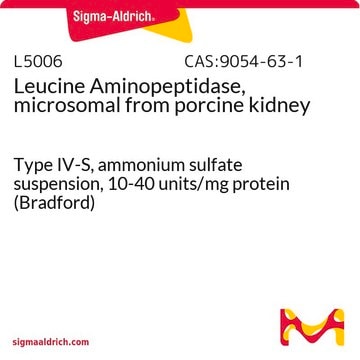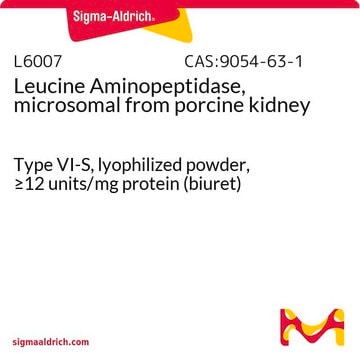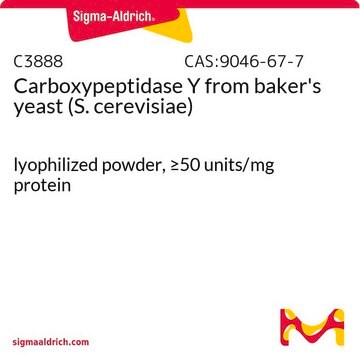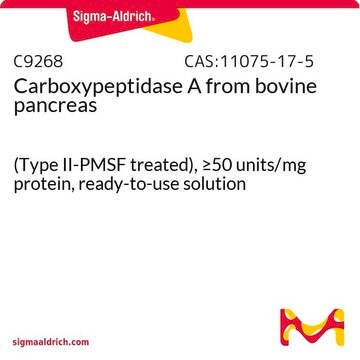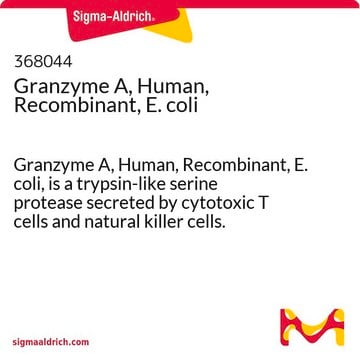164598
Aminopeptidase M, Porcine Kidney
Synonym(s):
Aminopeptidase M, Porcine Kidney, Alanyl aminopeptidase, Aminopeptidase M, Aminopeptidase N
Sign Into View Organizational & Contract Pricing
All Photos(1)
About This Item
CAS Number:
MDL number:
UNSPSC Code:
12352202
NACRES:
NA.54
Recommended Products
General description
Aminopeptidase M (APM) is abundantly found in brush border membranes of the kidney, small intestine, placenta, and liver. It is a type II integral membrane protein, known as ectoenzyme.
Application
Aminopeptidase M, porcine kidney has been used:
- to test and identify the peaks containing d-residue in the allatotropin-related peptide (ATRP)
- to study its oxidative inactivation of enzyme activity, and to screen MIRA ingredients
- for the proteolysis of isolevuglandins (IsoLGs) proteins
Biochem/physiol Actions
Aminopeptidase M (APM) is implicated in terminating the actions of certain neuropeptides, like the enkephalins and angiotensin III in the brain. It also metabolizes specific vasoactive peptides. It functions as a receptor for certain viruses, such as coronavirus 229E. APM is a nonspecific peptidase, which rapidly breaks down l-residue peptides.
Packaging
Please refer to vial label for lot-specific concentration.
Warning
Toxicity: Harmful (C)
Unit Definition
One unit is defined as the amount of enzyme that will hydrolyze 1 µmol of Leu-pNA per min at 37°C, pH 7.2.
Physical form
Crystalline suspension in 3.2 M (NH₄)₂SO₄, 10 mM MgCl₂, 10 mM Tris-HCl, pH 7.5.
Other Notes
Wachsmuth, E.E., et al. 1966. Biochemistry5, 169.
Legal Information
CALBIOCHEM is a registered trademark of Merck KGaA, Darmstadt, Germany
Storage Class Code
12 - Non Combustible Liquids
WGK
WGK 2
Flash Point(F)
Not applicable
Flash Point(C)
Not applicable
Certificates of Analysis (COA)
Search for Certificates of Analysis (COA) by entering the products Lot/Batch Number. Lot and Batch Numbers can be found on a product’s label following the words ‘Lot’ or ‘Batch’.
Already Own This Product?
Find documentation for the products that you have recently purchased in the Document Library.
Customers Also Viewed
Handbook of Proteolytic Enzymes (2012)
Oral Delivery of Peptide Formulations and Their Cellular Evaluation
Patil S, et al.
International Journal of Peptide Research and Therapeutics, 27(4), 2831-2844 (2021)
James W Checco et al.
The Journal of biological chemistry, 293(43), 16862-16873 (2018-09-09)
l- to d-residue isomerization is a post-translational modification (PTM) present in neuropeptides, peptide hormones, and peptide toxins from several animals. In most cases, the d-residue is critical for the biological function of the resulting d-amino acid-containing peptide (DAACP). Here, we
Valery N Yermalitsky et al.
Analytical biochemistry, 566, 89-101 (2018-11-21)
Isolevuglandins (IsoLGs) are a family of highly reactive 4-ketoaldehydes formed by lipid peroxidation that modify the lysyl residues of cellular proteins. Modification of proteins by IsoLGs have been shown to contribute to disease processes such as the development of hypertension.
Our team of scientists has experience in all areas of research including Life Science, Material Science, Chemical Synthesis, Chromatography, Analytical and many others.
Contact Technical Service